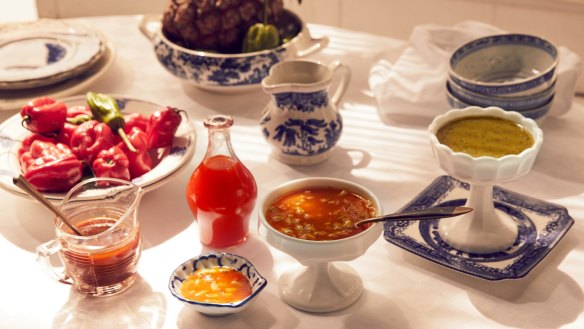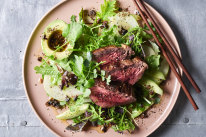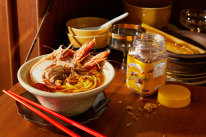Fermented hot sauce, three ways

Super-hot chillies such as habaneros often have intoxicating floral aromas. But as the name implies, they're so hot that you can't eat them without blowing your head off. This is where lacto-fermentation comes in, creating complexity, an almost sparkling acidity and helping to tone down aggressive spiciness. It sounds scary but fermentation is one of the simplest processes in the kitchen. Here are three flavour combinations to get you started, all using the same basic method.
Ingredients
1. Charred habanero and garlic
150g habanero chillies, charred over an open flame, barbecue or under the grill, stems removed
6 garlic cloves, sliced
2. Peach and jalapeno hot sauce
225g peaches, skin and seeds removed, flesh diced
75g jalapenos, stems removed and halved
3. Tomatillo verde
225g tomatillos*, halved
75g green chillies, halved
4 garlic cloves, sliced
1 brown onion, roughly chopped
2 tsp cumin seeds, toasted
Method
1. Place a sterilised jar on a kitchen scale and fill the jar 2/3 full with the ingredients from one of the three options suggested. Tare the scale (zero out the weight of the jar and its contents) and just cover the ingredients with cool water. Record the weight of the water, then drain off the water into a bowl.
2. Calculate 2 per cent of the weight of the water and measure out that quantity in salt. So if you used 1 litre (1kg) of water, you'll need 20g salt.
3. Dissolve the salt in the bowl of water and pour the salty water back into the jar over the chillies.
4. Keep the chillies and vegetables/fruit submerged (with fermentation weights or a ziploc bag filled with water) and cover loosely with a lid or cloth with a rubber band.
5. Place the jar in a warm, dark spot for 5-7 days, until the brine looks cloudy and bubbles begin to appear. Taste daily from the fifth day, using a clean spoon, until the brine has a pleasant sour flavour.
6. Strain out the chillies and vegetables/fruit, keep the delicious brine** and blitz the solids in a food processor until smooth, adding some of the brine until it reaches your desired consistency.
7. Pour the sauce into a sterilised jar and store in the fridge for 3-6 months.
8. Open the bottles in the fridge once in a while to let any gas buildup escape as the fermentation process continues. You don't want hot sauce blowing up in the fridge!
*Tomatillos look like small green tomatoes in papery husks. They are in the same family as a tomato but the flavour is more tart. To substitute, use underripe tomatoes and add a squeeze of lime juice.
**Use the leftover brine for seasoning dishes that need a little acid and heat, such as a salad dressing, a spicy margarita cocktail or use it to brine a bird for amazing fried chicken.
See also: my tropical hot sauce recipe
Appears in these collections
The best recipes from Australia's leading chefs straight to your inbox.
Sign up









